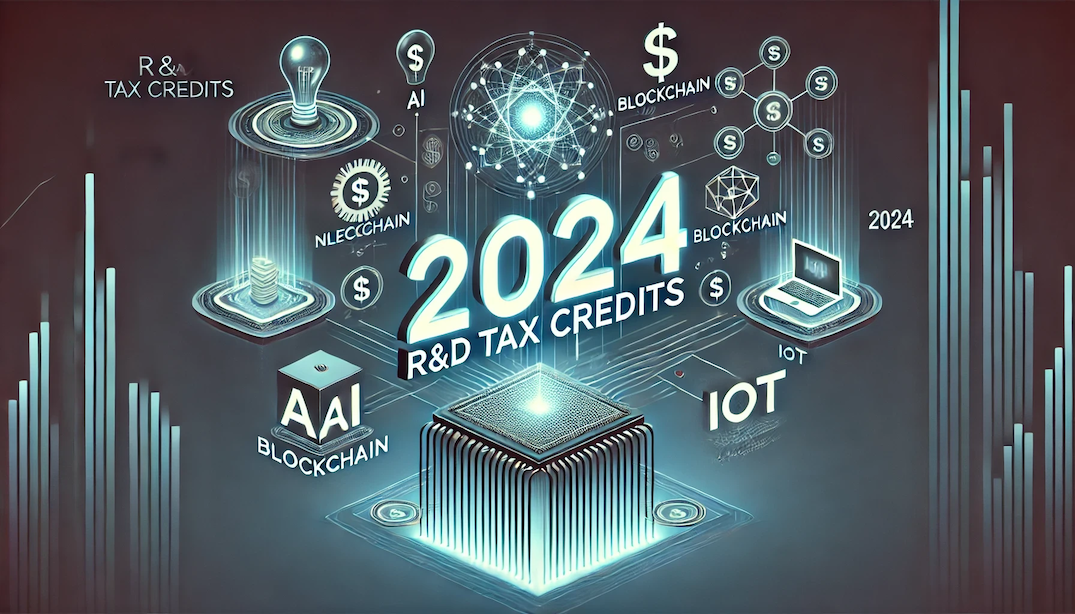R&D Tax Credits in 2024: AI, Blockchain, and IoT
In 2024, the landscape of R&D tax credits is undergoing a seismic shift, with artificial intelligence, blockchain, and the Internet of Things (IoT) at the epicenter.
For businesses leveraging these technologies, the potential tax savings are substantial – but so are the complexities. Did you know that a mid-sized tech company recently secured over $2 million in R&D tax credits for their AI-driven healthcare solution?
Or that a blockchain project in supply chain management led to a $500,000 credit for a logistics firm? These aren’t isolated cases; they’re the new norm in the world of R&D tax incentives.
Key Takeaways:
- R&D tax credits are evolving to accommodate AI, blockchain, and IoT projects, offering significant financial benefits for innovative companies.
- Recent IRS changes require more detailed documentation of R&D activities, emphasizing the need for meticulous record-keeping.
- AI projects can qualify for 20-25% credit rates, blockchain for 15-20%, and IoT for 18-22%, depending on specific activities and jurisdictions.
- Emerging trends include increased focus on sustainability and potential expansion of credit rates for projects addressing national priorities.
- To maximize benefits, align R&D projects with qualifying activities, leverage technology for compliance, and stay informed about policy changes.
- Future-proof your R&D tax strategy by building cross-functional teams and investing in adaptable data management systems.
Recent Changes Reshaping R&D Tax Credits
Key Changes for 2024
Documentation
- ✅ More detailed project-specific info required
- ✅ New Form 6765 optional for 2024, mandatory from 2025
Emerging Technologies
- ✅ AI projects: 20-25% potential credit rate
- ✅ Blockchain: 15-20% potential credit rate
- ✅ IoT: 18-22% potential credit rate
State-Level Changes
- ✅ Missouri: New R&D credit for startups
- ✅ Kansas: Increased credit from 6.5% to 10%
- ✅ Arizona: New simplified credit methodology
The IRS has ushered in significant changes for the 2024 tax year, starting with Form 6765. This updated form, while reducing the information burden on small businesses and startups, still demands a more granular breakdown of R&D activities.
Key points to note:
- Project-specific details are now required, emphasizing the need for meticulous documentation of each R&D initiative.
- The form will be optional for the 2024 tax year but mandatory from 2025 onwards.
- Certain taxpayers may be exempt from the new requirements – understanding your company’s position is crucial.
At the state level, the playing field is also evolving:
- Missouri introduced a new R&D credit with a specific fund for minority-owned, women-led, and startup companies.
- Kansas increased its R&D credit from 6.5% to 10% and made it transferable, opening new possibilities for monetization.
- Arizona adopted an alternative simplified credit methodology, potentially broadening access to R&D credits.
These changes underscore a growing recognition of R&D’s role in economic growth, particularly in emerging tech sectors.
Emerging Technologies: A New Frontier for R&D Credits
Artificial Intelligence (AI)
AI projects are becoming a hotbed for R&D tax credits. Qualifying activities often include:
- Developing new machine learning models
- Enhancing existing AI algorithms for improved accuracy or efficiency
- Integrating AI into traditional industries like healthcare or finance
Case Study: A healthcare startup developed an AI system for early disease detection. Their $5 million investment in R&D translated to a $1.25 million tax credit, effectively funding a quarter of their research budget.
Key Consideration: Document the technological uncertainties overcome in your AI projects. This documentation is crucial for substantiating your credit claim.
Blockchain
Blockchain development can qualify for substantial R&D credits, particularly in areas like:
- Creating new consensus mechanisms
- Enhancing security protocols
- Developing industry-specific blockchain applications
Case Study: A financial services company’s blockchain project for secure, real-time transactions initially cost $3 million but resulted in a $750,000 R&D tax credit, significantly offsetting their innovation costs.
Pro Tip: Leverage blockchain’s inherent record-keeping capabilities to maintain an audit trail of your R&D activities – a feature that aligns perfectly with IRS documentation requirements.
Internet of Things (IoT)
IoT projects often qualify for R&D credits, especially when involving:
- Custom sensor development
- Integration of IoT systems in manufacturing processes
- Advanced data analytics from IoT networks
Case Study: A smart home device manufacturer’s IoT project, costing $4 million, qualified for a $1 million R&D tax credit, effectively subsidizing 25% of their innovation costs.
Strategic Approach: Use IoT data collection capabilities to automatically log R&D activities, creating a real-time, verifiable record of your innovation process.
Maximizing Your R&D Tax Credits in the Digital Age
Embrace Detailed Documentation
With increased IRS scrutiny, maintaining comprehensive records is non-negotiable. Implement systems to track:
- Project objectives and hypotheses
- Experimentation processes and outcomes
- Time allocation of technical staff
Align Projects with Qualifying Activities
Ensure your tech projects meet the four-part test for qualified research:
- Permitted Purpose
- Elimination of Uncertainty
- Process of Experimentation
- Technological in Nature
Leverage Technology for Compliance
Use project management tools and time-tracking software that align with R&D tax credit requirements. This not only aids in documentation but can also uncover previously overlooked qualifying activities.
Stay Informed on Policy Changes
Tax laws are evolving rapidly, especially concerning emerging technologies. Regular consultations with R&D tax specialists can help you stay ahead of changes and optimize your claims.
Consider the Holistic Impact of Your R&D
Look beyond direct research activities. Integration of new technologies often leads to process improvements across your organization, potentially expanding your pool of qualifying expenses.
Comparison of R&D Tax Credit Potential Across Technologies
| Technology | Potential Credit Rate | Key Qualifying Activities | Documentation Challenges |
|---|---|---|---|
| Artificial Intelligence | 20-25% | Algorithm development, Neural network design | Proving technological advancement |
| Blockchain | 15-20% | Consensus mechanism design, Smart contract development | Differentiating from existing solutions |
| Internet of Things | 18-22% | Sensor integration, Data analytics | Tracking distributed development efforts |
Future-Proofing Your R&D Tax Strategy
As we look towards 2025 and beyond, several trends are likely to shape the R&D tax credit landscape:
- Increased emphasis on sustainability and green technologies
- Potential expansion of credit rates for projects addressing national priorities (e.g., cybersecurity, renewable energy)
- Greater integration of AI in the tax filing and auditing process itself
To stay ahead, consider:
- Aligning your R&D roadmap with these emerging priorities
- Investing in robust data management systems that can adapt to evolving reporting requirements
- Building a cross-functional team (tech, finance, legal) to manage your R&D tax credit strategy
Conclusion: Turning Innovation into Financial Advantage
The convergence of emerging technologies and R&D tax credits presents a unique opportunity for forward-thinking businesses. By understanding the nuances of qualifying activities in AI, blockchain, and IoT, and adapting to the new documentation standards, companies can turn their innovation investments into significant tax advantages.
Remember, the landscape is constantly evolving. What qualifies for a credit today might change tomorrow. Stay informed, stay documented, and most importantly, keep innovating. Your next breakthrough could be more than just a technological advancement – it could be a financial game-changer for your business.
For more insights on maximizing your tax benefits, explore our guides on reducing taxable income and understanding effective tax rates.




